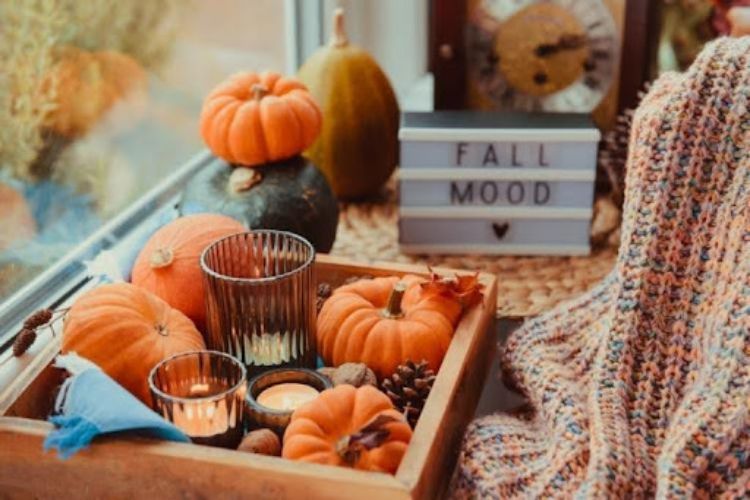Fall is one of the best times to switch up your home’s interior design. It’s a fantastic opportunity to test your decorating skills to suit the season. But decorating rooms is not always easy. There are elements you need to consider, the right colors you need to pick, and certain textures that work better than others.
If decorating for fall feels more like a chore than a fun, creative pursuit, keep reading. This piece will lay out some tips to mix different textures and the season’s colors like a pro.
Choose Your Color Palette
The hue you choose for your decor is the base for your other desired colors and textures. Fall typically calls for orange to match the fiery shades of leaves and pumpkins ripe for harvest. However, deep reds and warm browns are also great choices.
Choosing a color palette makes it easier to select the right decorations. For instance, a palette that involves fall’s traditional colors won’t push you to reach for something green or purple. The top decor ideas for fall 2025 call for warmth, coziness, and style. Accents like textiles or dinnerware should match the palette to create cohesiveness.
Regardless of the season, a neutral shade will always be the best first color option. White, beige, and even black work well with most colors, especially warm ones. A neutral color balances the intensity of more vivid shades so that the overall look doesn’t hurt the eyes.
Combine Natural, Fall-Themed Elements
Fall decor isn’t limited to throw pillows or table runners in reds and oranges. The season is prime time to incorporate natural elements.
Go for vibrant decorative pumpkins, nests made of sticks, and dried leaves on a fireplace mantle. Meanwhile, seasonal fruits like apples and pears in a wooden bowl make excellent centerpieces for a dining table.
Why not consider dried flowers and other dried fall foliage? These natural additions make great partners for cozy textures.
Balance Your Design with Soft and Hard Textures
Much like mixing and matching clothing, you can do the same when decorating for fall. A good play on texture could boost comfort faster than colors do. Pair soft and structured materials to create visual and tactile harmony.
For example, if your couch has soft, chunky blankets, put a wicker basket of acorns and red leaves on a side table. A jute rug under a leather chair or a velvet pillow on a wooden bench gives the eye somewhere to rest.
Mix coarse and smooth textiles like flannel or silk in small accents, such as fall throw pillows or cushions. Texture variety keeps a room’s appearance dynamic without relying on major color changes.
Play Around with Height and Depth
When every piece of furniture is around the same level, things can get a little bland. Interior design is just another art form, and art is effective when the eye moves through layers of height and shadow. While decorating for fall, maximize the use of autumn decorations in varying heights for more visual impact and appeal.
Take, for example, a knee-high coffee table. You can put a tall glass vase in the center, fill it with much taller sunflowers, and then surround its base with tiny faux pumpkins.
Experiment with depth, too, which comes from layering. Try overlapping rugs or using curtains with different weights. A thick linen curtain behind a sheer panel softens light and adds warmth.
Remember to consider visual balance when layering different fall decorations. Heavier textures like wool or leather ground the room best near the floor, while lighter materials such as lace or glass feel better higher up. This minor adjustment steadies the overall composition.
Integrate Unexpected Materials and Finishes
Mixing in something unexpected keeps decorating for fall from feeling repetitive. Add aged metal, concrete, or brushed brass to offset soft fall fabrics. These touches give the space a contemporary edge without losing warmth.
Transparent materials also add some freshness. Use frosted glass, gauzy curtains, or translucent candle holders to let light pass through dense palettes. Airy materials can make dark autumn tones feel lighter and more breathable.
Handmade details bring personality to your seasonal setup. A hand-thrown ceramic vase, woven basket, or artisanal mug adds texture that feels human.
Finish with an Anchoring Scent
Smell is a powerful sense that helps trigger memories and elicit certain emotions. So, including a particular scent will tie in every element of your fall interior design.
Consider a sweet, fall-related aroma, like oranges, apples, and maple syrup. Meanwhile, cinnamon, sage, and clove make a home smell like you’re baking something 24/7. Pick something you’ll never be tired of smelling that’s generally pleasant enough for most people. Make sure you also select scents that aren’t toxic to your pets.
There are many ways to effortlessly fill a room with a certain scent. That includes fall-scented candles, potpourri jars, and dough bowls. Make sure you position these items away from the reach of your pets, as some scents may be toxic to them.
Wrapping Up
Decorating for fall can be a fun and satisfying experience when you know how to do it properly. Start with a specific color palette, then work on the details, from layering different textures, heights, and depths. Top it off with some unexpected finishes and a scent telling your brain, ‘It’s fall!’
Apply these fall decor ideas to prepare your home for the season. Trust your creative instincts and pick what makes you happy. Ultimately, what matters is how you feel about a room’s design.

